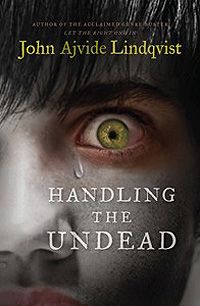
I recently finished Handling the Undead, Swedish author John Ajvide Lindqvist’s acclaimed follow up to Let The Right One In. Handling the Undead is actually several years old now and has only recently been published in the UK (on the back of the LTROI movie success.) It first saw light in Sweden back in 2005 but it took four years for the English translation to appear. Never mind. Better late than never I guess.
The story goes something like this:
For some inexplicable reason the recently deceased of Stockholm (those dead for up to six months) have come back to life. This includes all those who have been buried as well as those previously undiscovered bodies including, in one memorable incident, a man who had drowned in a lake and whose body had been hidden beneath the water for weeks. Needless to say he is not in a good state when he wakes up. But these ‘reliving’ are not quite the people they once were. There are aspects that are familiar but they seem to be more robotic and instinctual. And they also appear to have a strange psychic effect on regular living people whenever they come together in any number. The book focuses equally on several main characters and how they each deal with the reappearance of their recently departed. There is David, a stand up comic, whose wife was killed in a car crash the same night as the mass resurrection and who has been left to care for his young son. Meanwhile, teenage metaller, Flora, and her Catholic grandmother, Elvy, are horrified when the reanimated corpse of Flora’s granddad, Elvy’s husband, arrives at their front door. And then there’s middle-aged journalist Mahler who, upon discovering what has happened, goes to the local cemetery and digs up the reliving body of his young grandson Elias who recently died in a tragic accident.
Now, a lot of this is pretty grim stuff, especially everything to do with little Elias. The little boy is a dried up corpse, yet he is also reliving. Mahler and his grief-struck daughter’s continual and rather hopeless attempts to help Elias appear and to act more human by bathing him, moistening his desiccated skin with lotion and training him to react to simple things, is difficult stuff to read. Lindqvist’s prose is simple but very descriptive and highly emotional. He doesn’t shy away from intense imagery that will make you feel rather queasy. But even so, Handling the Undead is not really a horror story. Rather it is a grim, sad fable about life and the meaning of death. It is about how people deal with death, how they rationalise it, live with it, make it in to something else through the use of religion or even make it in to entertainment using more modern cultural outlets like movies and video games. The novel’s reliving are quite similar to the classic Romero zombie in that they shuffle around and many are in a very bad way, but they don’t eat people as their Hollywood cousins do. Lindqvist uses zombie films and video games such as Resident Evil (which shows up a lot in the story) as the touchstone for how people, mostly younger people, relate to the reliving, how they dehumanise them even though there is still a spark of their humanity remaining. The book follows several groups of characters and the emotional, psychological and actual physical journeys they go on in dealing with the return of their loved ones and of the wider event. This is not a story about plot twists and turns. It is a story about people, their emotions and how they deal. Or don’t deal. It is a journey of grief, faith and eventual acceptance. There is no big climax, no big revelations. The ending is like the rest of the book: quiet, sad and emotional.
There is no doubt that Handling the Undead is a good book. It is well written, atmospheric and quite disturbing in places. However, as with Lindqvist’s Let The Right One In, I found that the story, though compelling, meandered a little too much for my taste. There are many scenes where nothing much really happens, scenes that seem to just go off to places I wasn't really that interested in them going, wishing Lindqvist would just cut back to the central idea and perhaps focus more on some fewer characters. The wonderful thing about the film of Let The Right One In is how Lindqvist (who also wrote its screenplay) pared down his book to the core story and theme. He jettisoned the subplots and the excess fat from the book with the result being that the film was a superior telling of the story than the book it was based on. Don’t get me wrong, Handling the Undead is certainly a good book with an interesting and thought provoking approach to the zombie genre. I did like it. But if only it had been rather more focussed then it could have been a classic.

John Ajvide Lindqvist just came out with a new book in Sweden called "Little Star". It doesn't sound like one of his better stories and I don't even know if the story qualifies as horror but according to the reviews it has some kind of werewolf theme...
ReplyDeleteA werewolf theme? I'm sold. :D
ReplyDelete